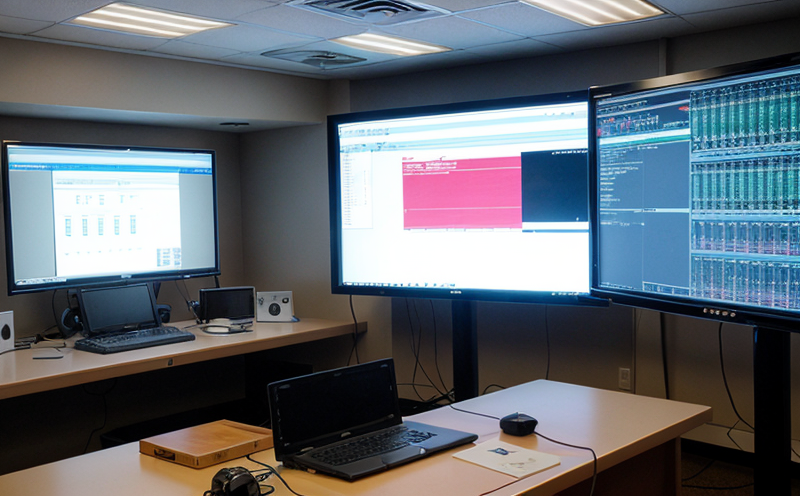EN 50121-4 EMC Testing of Trackside Signaling Equipment
The EN 50121 series is a set of European standards aimed at ensuring the interoperability and safety of railway signaling equipment. Among these, EN 50121-4 specifically addresses the electromagnetic compatibility (EMC) requirements for trackside signaling systems in railway applications.
EMC testing ensures that electronic devices do not emit excessive electromagnetic interference (EMI), which could potentially disrupt other equipment or networks operating within their vicinity. In the context of railway signaling, this is crucial to maintain operational integrity and safety.
The test parameters for EN 50121-4 are designed to evaluate how trackside signaling systems behave in an electromagnetic environment that mimics real-world conditions during operation. This includes testing for both conducted and radiated emissions within the frequency ranges specified by the standard.
To perform these tests, we use sophisticated instrumentation such as high-frequency measuring antennas, power supply units with specific output characteristics, and measurement equipment capable of accurately detecting even minute levels of electromagnetic interference. The specimens are typically trackside signaling devices like interlocking systems, block signaling systems, and wayside transponders.
Preparation for the test involves ensuring that all components of the signaling system under test are properly connected according to manufacturer specifications and operational requirements. This ensures accurate measurement results reflecting real-world performance scenarios.
The testing procedure follows a step-by-step approach outlined in EN 50121-4, which includes setting up the test environment, connecting the specimen to appropriate interfaces, applying specified electromagnetic fields through controlled sources, monitoring the response of the device under test (DUT), and evaluating whether it meets all acceptance criteria stipulated by the standard.
Acceptance criteria for successful completion of EN 50121-4 tests are stringent. They ensure that the tested trackside signaling equipment can operate correctly without causing unacceptable interference to other railway systems or facilities within its electromagnetic environment. Compliance with these standards is essential for maintaining reliable communication between different parts of a railway network, thereby enhancing overall safety and efficiency.
Our facility adheres strictly to all relevant international standards including EN 50121-4 when conducting EMC tests on trackside signaling equipment. We employ highly skilled engineers who understand both the theoretical aspects of EMC as well as practical considerations associated with railway applications. Our state-of-the-art laboratories provide controlled environments where precise measurements can be made under simulated operational conditions.
By choosing our EN 50121-4 EMC testing services, customers benefit from comprehensive support throughout each stage of the process—from initial consultation to final certification report delivery. We offer expert advice on best practices for preparing specimens and interpreting results, ensuring that clients achieve compliance with all necessary regulations while minimizing downtime associated with rework or failure.
We pride ourselves on delivering accurate, reliable test data that helps our customers make informed decisions about their products' suitability for use in railway environments. Our goal is not only to meet but exceed the expectations of those responsible for ensuring safe and efficient rail operations worldwide.
Scope and Methodology
The scope of our EN 50121-4 EMC testing service includes all aspects related to assessing electromagnetic compatibility within the context of trackside signaling equipment used in railway applications. This encompasses both conducted and radiated emissions over defined frequency bands.
Our methodology follows closely with the guidelines provided by EN 50121-4, which specifies detailed procedures for setting up test facilities, preparing specimens, applying electromagnetic fields, and measuring responses from the DUT (Device Under Test). Each step is carefully documented to ensure reproducibility and consistency across multiple tests.
For conducted emissions testing, we use specialized equipment like high-frequency power supplies that deliver precise voltages at various frequencies. Radiated emissions are tested using anechoic chambers equipped with appropriate antennas capable of emitting or receiving signals over the required frequency range.
The specimens for these tests consist primarily of trackside signaling devices such as interlocking systems, block signaling equipment, and wayside transponders. These components must be connected correctly to simulate actual operating conditions accurately.
Industry Applications
| Application Area | Description |
|---|---|
| Interlocking Systems | These systems control the movement of trains and shunting operations at a railway station. They ensure that signals are correctly set when a train approaches or departs, preventing collisions. |
| Block Signaling Equipment | This equipment divides the railway into sections known as blocks to prevent two trains from occupying the same section simultaneously. Proper EMC performance is critical here since any interference could lead to hazardous situations. |
| Wayside Transponders | Transponders communicate with on-board train equipment to provide information about track occupancy, speed restrictions, and other operational data. Ensuring proper EMC ensures reliable communication between these systems. |
Customer Impact and Satisfaction
By choosing our EN 50121-4 EMC testing services, customers enjoy several key advantages:
- Compliance Assurance: Ensuring that all products meet the rigorous standards set forth by EN 50121-4 helps companies avoid costly penalties and reputational damage associated with non-compliance.
- Improved Product Quality: The detailed testing process identifies potential issues early in the development cycle, allowing manufacturers to address them before product launch.
- Informed Decision-Making: Our comprehensive reports provide valuable insights into how a particular piece of equipment performs under various electromagnetic environments, aiding in strategic business decisions.
We are committed to exceeding our customers' expectations by providing top-notch service and support. Feedback from satisfied clients reflects their confidence in the quality and reliability of our services.





